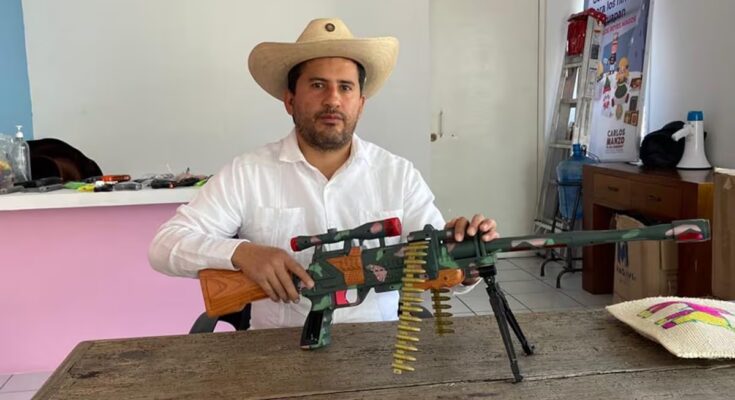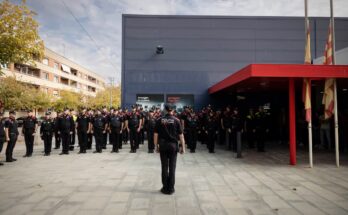A large caliber weapon, a sniper rifle, with its bipod and telescopic sight, the series of bullets hanging from that animal of death… Carlos Manzo takes it as if it were the leg of a wounded and distraught horse, his hands on the hocks and the pastern: a strange image. The accompanying text makes it clear that the contraption is, in fact, a toy rifle. A child gave it away in exchange for a cart. “Every day we will exchange these toys for others, which are more beautiful to live together in harmony,” continues the text. The scene is impressive, Manzo with his characteristic hat, the image of his nascent political movement, his white guayabera and cotton backpack, the friendly reverse of one of his crusades, the fight against crime.
Published on his Facebook account, the photo in question was taken in Uruapan, in the state of Michoacán, in January 2023. Manzo was then a federal deputy, a position he had achieved a couple of years earlier, at the hands of Morena. The politician had just inaugurated the “Sombrero community guard” in the municipality, his house of connection with the inhabitants of the neighborhood, approximately 350,000. There he set up offices, a pharmacy and then made it a launching pad for his campaign for the municipal presidency, an election he would win a year and a half later. But in January 2023, Manzo posed there with several toy guns, some resembling a real 9-millimeter pistol, the weapon used by his killer a week ago when he attacked him with bullets in the town center.
Seven bullets ended Manzo’s life, and he died in the midst of a Day of the Dead celebration in his native Uruapan, with the square filled with catrinas and rancheros. The attack was caught on video as many people recorded how neighbors lit candles under a giant catrina. From the first moment, on Saturday night, anger grew, between marches and protests, in Uruapan and Morelia, the state capital, a weariness against criminal violence, which ignited like other massacres and other violent events in the past, such as the massacre of members of the LeBarón-Langford-Miller families, in Sonora, in 2019, or before, keeping distance, the disappearance of 43 normalistas students in Guerrero, in 2014.
After initial hesitations, the federal government, led by Claudia Sheinbaum, extraordinary convened the security cabinet on Sunday, a meeting that served to convey an image of urgency. Michoacán was becoming a problem. The attack on Manzo came just a week after the murder of Bernardo Bravo, a leader of lemon producers in the region surrounding Uruapan. If in political terms the Bravo case represented a harsh wake-up call, the attack against Manzo forced a change of pace. For months the Executive has been boasting of a reduction in high-impact crimes, but this has blown up any statistical table.
During the first months of Sheinbaum’s term, criminals had already killed a handful of mayors, but Manzo was special. He was a very popular politician, already distant from Morena, who had campaigned by criticizing his predecessors’ lukewarmness towards crime; a man who had fought corruption in the local police and now had a presentable society; an official who wore a bulletproof vest to go on patrol and then bragged about arrests in his networks, whether it was a motorcycle thief or the local leader of the area’s predominant criminal group, the Jalisco New Generation Cartel (CJNG). If Bravo had distorted the gestures, the attack against Manzo lit the flames.
The government’s reactive logic didn’t help. The Security Cabinet knew about Michoacán’s problems from the beginning. In fact, his strategy for the first 100 days in power included attention to the state, in particular to the lemon area, where Bravo worked, where there is a very serious problem of extortion. In these 13 months of mandate, the Government has arrested some occasional extortionists, a national plague, has shown concern about the use of drones with explosives and anti-personnel mines in the fields of the area, has carried out operations here and there, such as that of the Navy in May, which ended with the death of 12 criminals, presumably in combat. But the problem persisted.
Not that it was easy to contain him. Michoacán has been a powder keg for more than 20 years, a testing ground for successive governments in terms of security. The connivance of politicians and criminals, the arrests and deaths of old bosses have led to a present in which more than a dozen criminal gangs, living in shifting alliances, fight to extort money from the wealthy local agricultural scene. Since the lemon is just one plot, then there’s the avocado, a crop based in Uruapan and surrounding areas that exports more than $3 billion a year to the United States. Also added to the equation is the production and consumption of drugs, particularly methamphetamines, a common thread in crime in the region.
Killed by the mayor’s bodyguards a few seconds after the attack, Carlos Manzo’s killer turned out to be a 17-year-old boy from Paracho, a little north of Uruapan. According to the Public Prosecutor, the young man, Víctor Ubaldo, was addicted to methamphetamine and had left home a week before the attack. In the images of the boy who distributed the addiction you can see a boyish face, his eyelids slightly lowered, his features soft. Not long ago, Víctor Ubaldo might have been one of the children who went to Manzo’s tent in January 2023 to trade their toy guns for cars or soccer balls. Now he is just another corpse, victim and executioner, a minor piece of the violent mechanism that grips Mexico.
In interviews released later this week, Michoacán prosecutor Carlos Torres made it clear that the gunman was part of the CJNG structure. It’s an explanation that doesn’t say much. On the one hand, EL PAÍS and other media had already spoken about the issue days ago. On the other hand, what’s the point of making such a statement, devoid of depth, without providing anything else? Because right now no one in the entire country knows how the CJNG captured Víctor Ubaldo; no one knows how he became addicted to methamphetamine; No one knows what life events led him to make the decision he made. The prosecutor’s explanation follows the path of many others in these years of massacres in the country, the data as tiles in the void, concepts such as CJNG and methamphetamine addiction, as paths towards a presumed tranquility.
Details of the killer’s identity became known as Carlos Manzo’s widow was sworn in as the new mayor of Uruapan, after visiting Claudia Sheinbaum, at the National Palace. Grecia Quiroz thus began life without her husband, the father of her children, the last one, a newborn of just 14 months. Her path seemed marked since Sunday, the day after the attack, when the woman placed the microphone on the wound in the town square, in homage to the murdered mayor. Between sobs, she shouted: “He was the only one who dared to raise his voice, to tell the truth, without fear of anything.” More than applause, the audience let out a low growl. If Quiroz had ordered a march on Mexico City, few would have doubted.

In the National Palace, action and caution have alternated in recent days with looks to the past. The condolences of the beginning have given way to criticism of past governments, which went in the opposite direction, causing, in their opinion, the current violence. Then, the Executive developed a new federal intervention plan to pacify Michoacán, an idea that, ironically, the presidents also criticized. Of course, Sheinbaum defends his humanist soul, different from that of others, he said, none so detested in Morena’s imagination as the military landing of Felipe Calderón (2006-2012), in his first days in office, when the presidential sash was barely adjusted.
The one who seems to be worse off at the moment is the governor of the state, Alfredo Ramírez Bedolla, also from Morena. The Central Executive looks at him with suspicion, restless and annoyed by his inattention to the problem of precariousness. In recent days Bedolla, in office for four years, has not insisted too much on defending himself. The president seemed affected by Manzo’s murder. It is not in vain that they both shared a campaign, way back in 2021, a job that ended with the first in the Government Palace of Morelia. After his term ended, in the midst of protests this week, protesters managed to take over the property. Their living rooms were filled with people screaming, throwing furniture out of the window.



